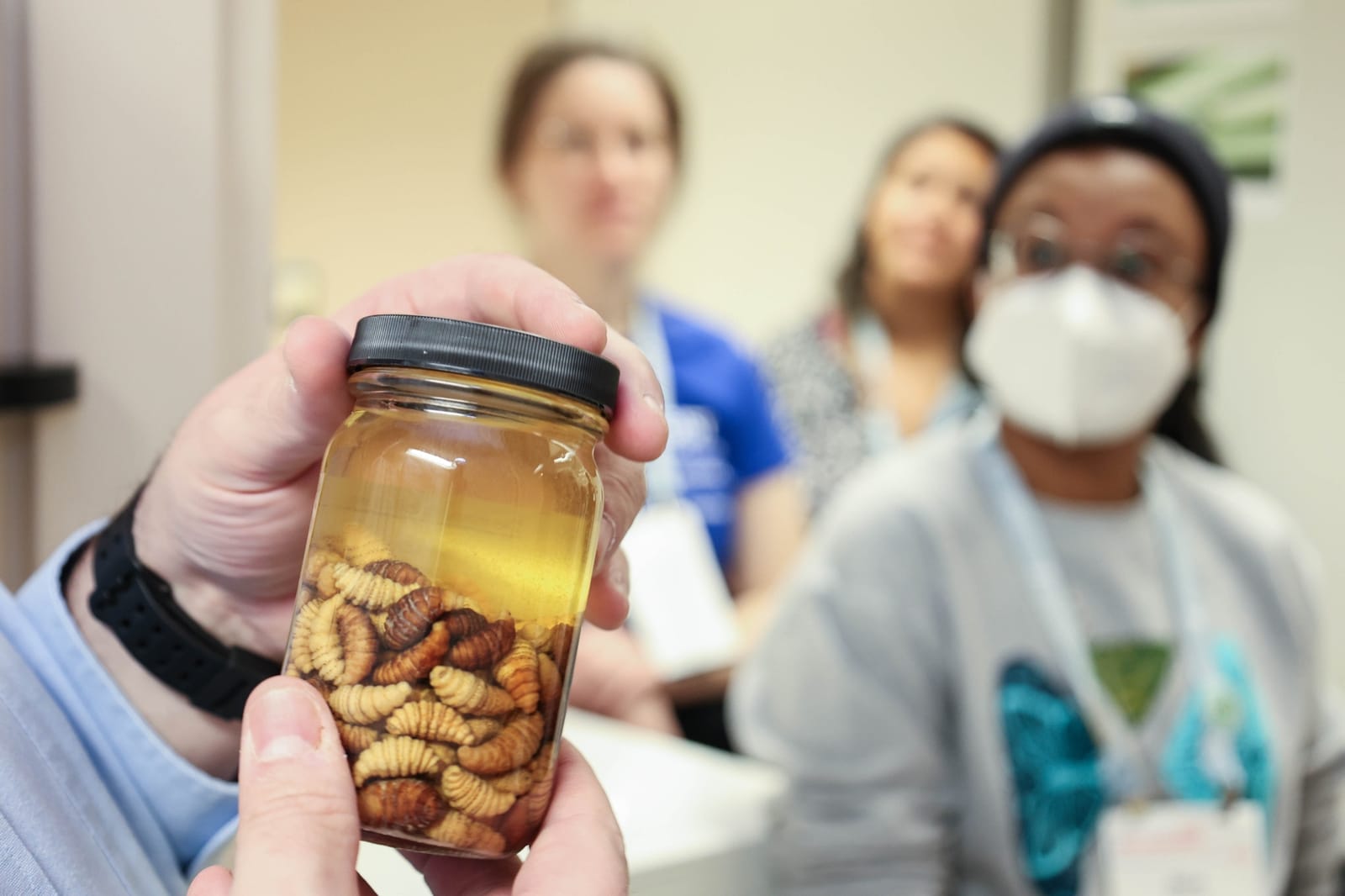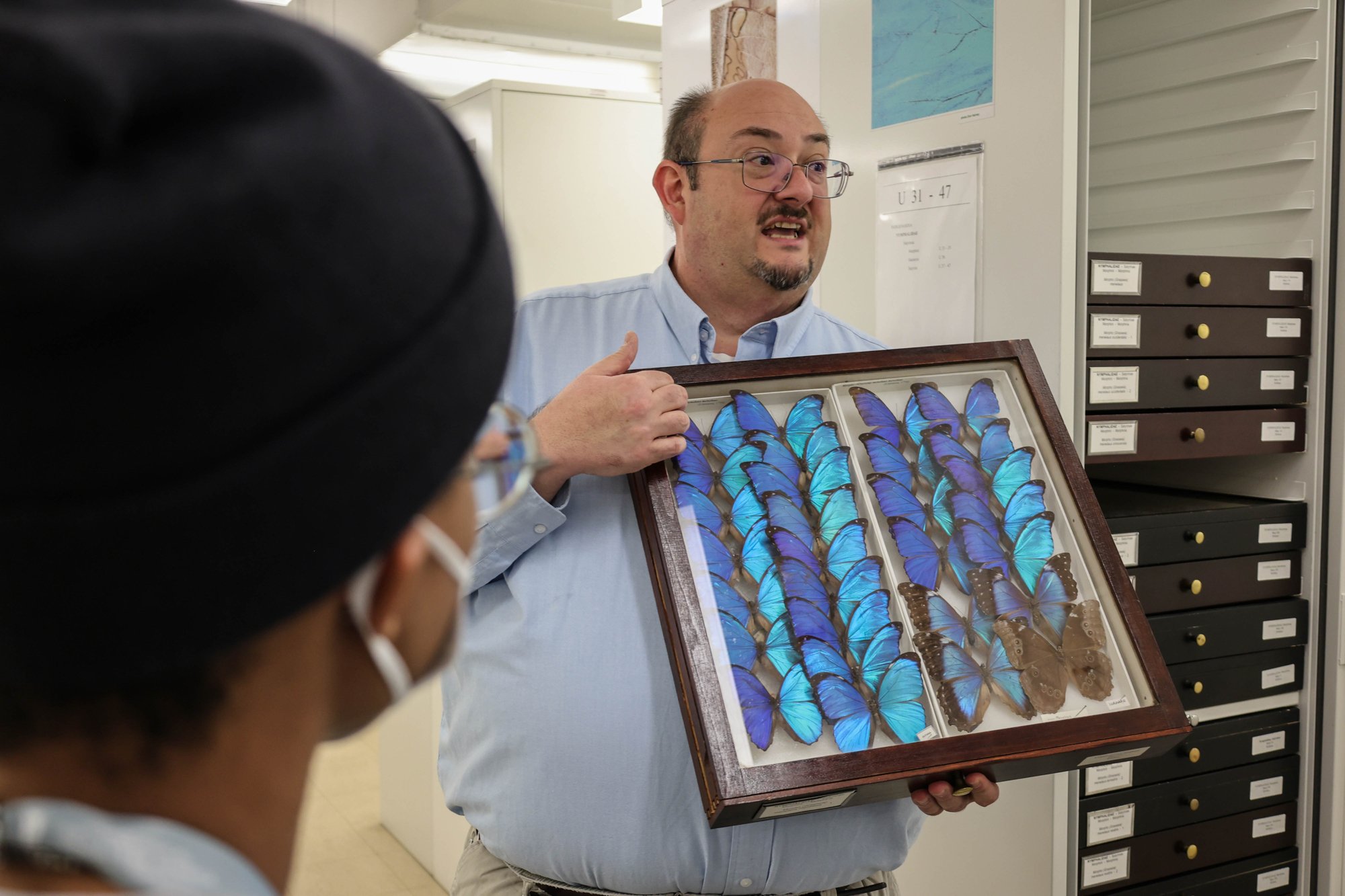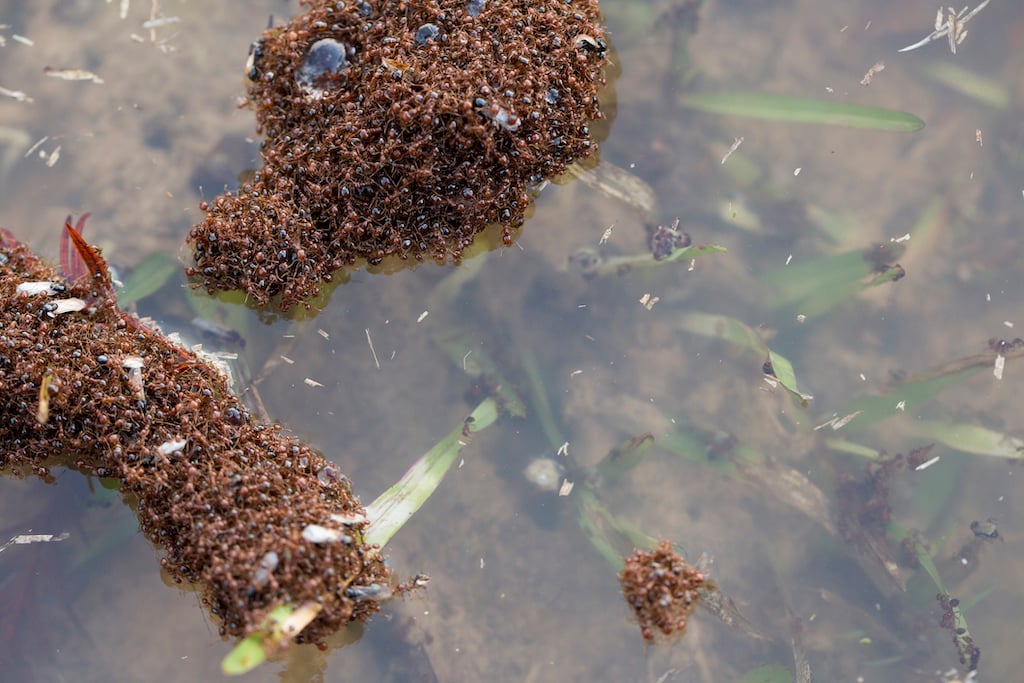The thing about insects is that there are a whole lot of them. Not just around the planet, where they account for about 90 percent of life forms, but also at the National Museum of Natural History’s entomology department, which comprises 1.3 million different species. More than 100 million objects are in the museum’s overall collection—and entomology accounts for about 23 percent of everything the Smithsonian Institution owns. That’s far too many specimens even for the enormous museum, and parts of the collection are kept in 11 other facilities around the country, including one in Honolulu.
Most of the insects aren’t usually viewable by the public, even if you’re just talking about the holdings in the DC building itself. But recently, a group of visiting bug scientists got a special-access tour, and I was able to tag along for a behind-the-scenes look. The scientists had come to town for the Entomological Society of America’s annual conference, held this past November at National Harbor’s Gaylord National Resort, and they took a break from whatever it is you do at an entomology conference to investigate the museum’s plethora of critters. The tour—one of several offered to conference attendees—was led by the Smithsonian’s Floyd W. Shockley, the entomology department’s collections manager and a specialist in beetles. Studying insects is the “gateway to understanding the natural world,” he told me later.
Shockley led the group on a mile-long tour of the two-thirds of the building not open to the public. We should all feel free to take photos, he said: “Everything you see belongs to the people of the United States.” The scientists were visiting from places such as Illinois, Oregon, and Florida. Isobel Ronai, who studies ticks at Harvard (and is thus technically an arachnologist rather than an entomologist), was particularly interested in seeing how the museum protects its specimens from getting damaged by insect infestations. “Funnily enough,” she said, “for entomology collections that are maintained in other museums, one of the biggest threats is actually other insects.”
The museum’s collection of creepy-crawlies includes about 34 percent of the species entomologists believe exist.
Our first stop was a massive room devoted to flies and aquatic insects, which is one of the main workspaces in the non-public part of the museum. Shockley explained that much of the activity in rooms like this isn’t actually museum-related. Smithsonian employees share space with workers from the US Department of Agriculture and the Department of Defense, both of which have a keen interest in issues such as pest control and disease spread and have long maintained a big presence inside the museum. In fact, more than twice as many USDA staffers work there as do Smithsonian employees. The museum’s bug collection actually originated with Charles Valentine Riley, who worked as the USDA’s chief entomologist in the late 19th century and donated more than 100,000 specimens to what’s now the Smithsonian Institution.
Today, the museum’s collection of creepy-crawlies includes about 34 percent of the species entomologists believe to be in existence. Many of the insects are stored in gray cabinets, which hold glass-topped wooden trays containing the dried insects on pins. “A lot of the collection is in storage mode, not in active research mode,” Shockley explained. The museum doesn’t have a big-enough staff, obviously, but also the vast majority of bugs aren’t of particular interest at any given moment. Still, someday they might be. Time is perceived differently in an institution that has meteorites as old as the Earth; Shockley said the next scientist who needs to study one of the critters “may not have been born yet.”
Shockley next led us to the back of the room, where he explained some of the challenges of preserving so many creatures. Certain specimens are stored in containers full of ethyl alcohol, a method that uses much less space but carries some risks. The room was marked with warning symbols, a relic of a post-9/11 executive order that directed agencies to reduce the amount of flammable material in federal buildings. As a result, the museum moved a lot of its collection to its support center in Suitland, but there are still quite a few vials, jars, and even drums full of insects floating in ethanol, which has flammable fumes. “I don’t think we’d be a terrorist target,” Shockley said, “but we could be collateral damage.” The Smithsonian also designed a system that sucks the air out of the room every three minutes and blasts it through a vent in the roof. If you drop a vial in this room, Shockley told us, the liquid will have dried by the time you return with a paper towel.
Storing bugs in alcohol has other downsides: The rubber stoppers eventually crack, and air bubbles can pop the tops off vials. Everything has to be maintained on a regular schedule, which involves putting on new stoppers and burping them with a piece of fishing line. Still, it’s a far more efficient system than the cabinets.
At one point, Shockley brought out a jar full of human-botfly larvae, which a layperson might call maggots. They can grow to almost an inch long; all of these originally came from a single unlucky cow. This being a roomful of entomologists, Shockley received a lot of appreciative nods when he said the botfly has a “cool life cycle.” The bug scientists were enjoying themselves. (Ronai later told me that ticks are “one of the few species where I have not come across anybody who says they’re in love with them.”)
It should be noted that the human botfly, which lives between southern Mexico and Uruguay, is, at least in the opinion of this non-expert, pretty gross. As the name suggests, it’s known for infesting people as well as animals, and Shockley told us he’s had two human-botfly maggots grow in him over the years. Such experiences are a “badge of honor for entomologists,” he insisted. The females produce analgesics and antibiotics, which is why once the maggots are inside you, the best course of action is simply to wait for them to leave. “I don’t recommend trying to pull them out,” he told me later. “They’re designed with hooks.”
After the tour, I asked other entomologists whether they’d had similar encounters with human-botfly maggots. None had. “I study pollinators,” said Michelle Boone, a postdoctoral researcher at Washington State University Vancouver whom I’d met on the tour. “We don’t have to [deal with] that.”

Next, Shockley pulled out several cabinets of what he called the department’s “oh, mys”—the bugs that tend to impress people who know about such things. A wild-looking insect whose eyes extend out from its head on sticks. Flies that are able to disguise themselves as bees. A tarantula the size of your dog’s head. Unusual kinds of stick insects, which thwart predators by looking astonishingly like foliage. Boone said she was especially fascinated by a tray that contained rows of dried makech, which are beetles that artists in Yucatán bedazzle with jewels while they’re still alive, then attach to a leash with a pin at one end so they become living brooches. “I’ve never seen anything like that before,” she said.
The visiting scientists were also intrigued by some less obvious aspects of the collection. One of them pointed out the size of the cabinets, which struck him as unusual. It turned out the Smithsonian had created custom dimensions; its cabinets are a bit smaller than the Cornell University and California Academy of Sciences cabinets prevalent in many entomological collections, allowing the Natural History Museum to jam more bugs into boxes.
That’s a good thing, because people keep giving it more insects. One hallway we passed is dominated by cabinets filled with about 45,000 moths and butterflies from the collection of a Romanian American doctor who lives outside Fresno. Even though the donor isn’t a trained entomologist, the collection is “remarkably well curated,” Shockley said. He gave it to the Smithsonian because he was out of space—and wanted to start over on a new collection. Despite its vast holdings, the museum still accepts collections it deems significant, which means about four or five donations of 25,000-plus specimens come in to be processed, cataloged, and stored each year.
But most of the time, Shockley finds himself politely declining. “If someone offers me 45,000 swallowtails, I’m going to say no to that,” he said, to knowing laughs from the scientists. (Google later tells me they’re a very common type of butterfly.) If he can’t help a would-be donor, Shockley tries to match the person with a local nature center or another possible home for their collection. “We want to recognize that just because we can’t take it doesn’t mean it’s not valuable,” he said.
But while Shockley probably won’t accept your bugs, he is generally willing to show you his. It turns out that you don’t have to be an entomologist to get access; he’s happy to give tours of the collection to any interested group that makes an appointment. He’s particularly excited to engage with fellow scientists. Even professionals “maybe never experienced a collection the size and breadth of ours,” Shockley said. “Most of my floors have more specimens than most universities have in their entire collections.” He also loves to show school groups around, especially because kids tend to be natural fans of invertebrates. “Everyone starts off an entomologist,” he said. “Some of us just don’t grow out of it.”
This article appears in the January 2024 issue of Washingtonian.
Correction: This article originally said the museum’s collection comprised 20 percent of described species. In fact, it comprises about 34 percent.




















